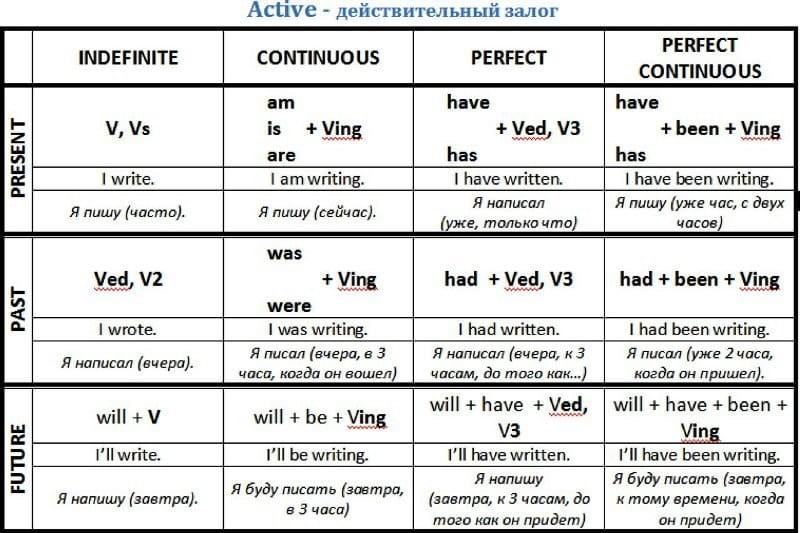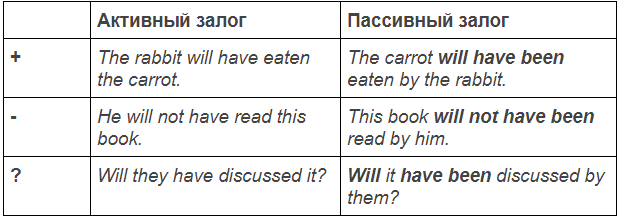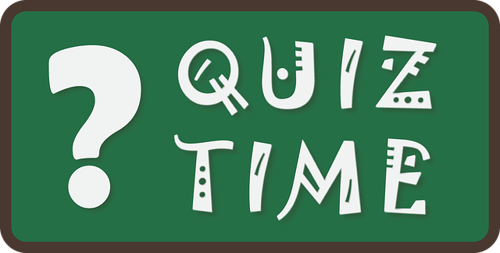Grammatical voice refers to the different grammar terms used to understand the relationship between the action done by the verb and the subjects, or objects, it affects. This explanation is all about the active voice.
Active voice definition
The active voice is used to show that the subject of the sentence is active and is performing an action on an object. In active voice sentences, the subject is the ‘doer’ of the verb. For example, in the sentence ‘The man ate the burger’ the subject (the man) is doing the action (eating).
We form the active voice through word order and the use of verbs. The word order in an active voice sentence looks like this: subject + verb + object. E.g. ‘The mouse ate the cheese’. The mouse (the subject) ate (the verb) the cheese (the object).
Active voice sentences also contain active verbs. These are verbs in the past, present, or future tense that follow a subject. E.g. ‘The woman painted her nails’. Active verbs are opposite to passive verbs, which are past participles that follow the words was/were. E.g. ‘The nails were painted by the woman’.
Active voice examples
The active voice occurs in sentences where the subject acts. This means that the subject will come first in the sentence, followed by the verb and finally the object. Let’s look at some examples of this.
| Subject | verb | Object |
| The early bird | ate | the worm |
| The children | ran | the race |
| The man | threw | the ball |
The active voice tends to follow a linguistic pattern that is referred to as subject-verb-object, this is sometimes shortened to SVO. This is a helpful way to spot the active voice within a text.

Difference between active voice vs passive voice
Grammatical voice doesn’t only include the active voice. The opposite of the active voice is the passive voice. This is very different to the active voice as here the subject is acted on by the verb. This means that instead of actively ‘doing’ the verb, the subject is instead passive. Below are three examples of passive voice:
- The movie will be watched by the children
- The fish was eaten by the cat
- The tires were changed by the mechanic
As we can see, these sentences are constructed very differently from the ones we saw in the previous example. Let’s look at how these sentences would be formed in the active voice:
- The children will watch the movie.
- The cat will eat fish.
- The mechanic will change the tire.
There is a noticeable difference between how these sentences are constructed. The active voice is far stronger than the passive voice in these examples. This is because of the placement of the subject in the statements. In the active voice, the subject takes on the primary position in the sentence and so is active and dominant in how the sentence is constructed. However, in the passive voice, the subject is placed last and so the sentence becomes less authoritative.
There is also a difference between the verbs in the active and passive voice. Whereas the active voice contains an active verb, the passive voice must contain the following;
-
A conjugated form of the verb ‘to be’, e.g. is, was
-
The main verb in its past participle form, e.g. eaten, written, read.
Here is a handy chart summarising the key differences between the active and passive voice:
| Active Voice | Passive voice |
| The subject comes first in the sentence | The subject comes last in the sentence |
| Direct and clear sentence structure | The structure becomes less clear |
| Can be constructed in any form. | Always made with a conjugated form of the verb ‘to be’ |
| Contains an active main verb | Contains the main verb in its past participle form |
In general, the active voice is used more commonly in everyday speech and writing. The active voice is then very important in how we make sentences every day!
Importance of the active voice
The active voice is the grammatical voice that we use the most in everyday speech. You will find that most of the sentences you write are in the active voice. There are many reasons that the active voice is important to your writing.
The reader will feel present in the work
The active voice is most commonly used in the present and future tense. This puts the reader in the moment. Take this example from Edgar Allen Poe’s ‘The Raven‘ (1845):
Once upon a midnight dreary, as I pondered weak and weary,
Over many a quaint and curious volume of forgotten lore
While I nodded, nearly napping, suddenly there came a tapping,
As of someone gently rapping, rapping at my chamber door.

Through the use of the active voice, the scene becomes more vivid than if the writer used the passive voice. The active voice helps to create a stronger connection to the action/scene for the reader. This is because sentences use both present and past tense verbs. When we consider this alongside the placement of the subject in the sentence, we can see that the imagery evoked becomes a lot clearer.
The active voice places the subject at the forefront of the sentence. The active role it takes means that the action of the sentence is more clearly and strongly depicted.
Active voice makes commands clearer
The active voice is also important in non-fiction. It is present in non-fiction texts such as newspaper articles, recipes, and instruction manuals. The active voice is commonly used here because it makes sentences sound clearer and more direct. It is important in this context as it can be used to create instructions and deliver facts efficiently. Let’s look at an example of this from a newspaper article
A swimmer who was rescued off the coast of Co Kerry on Sunday night has been identified as Ruairí McSorley, who previously went viral online for a TV interview he gave in 2015 in which he became known as «Frostbit Boy». Fenit RNLI and Rescue 115 were requested to launch by the Irish Coast Guard at 11 am on Sunday after clothes were discovered at Castlegregory beach by a dog walker. Volunteer lifeboat crew with Fenit RNLI spotted a head above water hours later at 8.30 pm and took the swimmer onboard an all-weather lifeboat.
Easy to understand
The active voice follows the simple subject-verb-object (SVO) sentence formula. This makes it easier to understand as the structure is simple. As the active voice allows for clear and simple sentences, it means that concepts can be broken down into their simplest forms. This means that the active voice is especially useful for teaching.
The Active Voice in Literature
The active voice is an important component of how sentences are constructed in Literature. This is because the active voice allows the writer to tell a story in a clear and direct manner. Have a look at the example below from The Great Gatsby (1925)
I rushed out and found her mother’s maid and we locked the door and got her into a cold bath. She wouldn’t let go of the letter. She took it into the tub with her and squeezed it up into a wet ball
Can you see the active voice in this extract? We can see that there are four examples of the active voice here. Let’s use the table below to better understand this:
| Subject | verb | Object |
| I | found | her mother’s maid |
| We | locked | the door |
| She | wouldn’t let go of | the letter |
| She | took | it |
We can see that the active voice is frequently used in this extract. This makes the paragraph direct and easy for the reader to understand. It is also used to create short bursts of information that provide readers with a clear view of the scene depicted. From this example, we can see how important the active voice is when used in literature.
Active Voice — Key takeaways
- The active voice is a type of grammatical voice.
- The active voice occurs in sentences where the subject actively performs the verb.
- Sentences in the active voice will follow the subject-verb-object structure.
- Active voice sentences contain active verbs.
- The active voice is more common than the passive voice, as it is more clear and more direct.
- The active voice is frequently used in both fiction and nonfiction texts.
Активный залог (active voice) показывает, что лицо или предмет, выраженное подлежащим, само производит действие.
Содержание
- Что такое залог в английском языке
- Активный залог (active voice)
- Таблица и примеры
Что такое залог в английском языке
Для начала давайте рассмотрим, что такое залог, и зачем он нужен в английском языке.
Залог выражает отношение к действию, то есть он показывает:
- человек/предмет сам совершает действие (я принес письмо)
- человек/предмет испытывает действие кого-то на себе (письмо принесли)
В английском языке выделяют два вида залога:
- Активный залог (Active voice) – действующее лицо само совершает действия.
Клиенты подписали договор (клиенты – действующее лицо, и они совершили определенное действие).
- Пассивный залог (Passive voice) – действующее лицо испытывает на себе действие другого лица.
Договор подписан (договор подписал не сам себя, действие было совершено над ним).
Активный залог (active voice)
Категория залога показывает, производит ли действие лицо (предмет), выраженное существительным или местоимением в функции подлежащего, или же оно само испытывает на себе чье-либо действие.
Активный залог (active voice) показывает, что лицо или предмет, выраженное подлежащим, само производит действие.
- Sam baked a big cake. / Сэм испек большой пирог.
В примере выше лицо, выраженное подлежащим (Sam) самостоятельно производит действие (baked), т.е. является активным. Таким образом, можно сказать, что предложение в целом употреблено в активном залоге.
Другие примеры предложений в активном залоге:
- Jeremy opened the present. / Джереми открыл подарок.
- Susan found her car keys. / Сьюзен нашла свои ключи от машины.
- James climbed the ladder. / Джеймс поднялся по лестнице.
- Kate has knitted this sweater herself. / Кейт сама связала этот свитер.
Таблица и примеры
- Active Voice :They usually visit their granny. — Они обычно навещают свою бабулю.
- Passive Voice:Their granny is usually visited. — Их бабулю часто навещают.
- Active Voice:They are visiting their granny now. — Сейчас они навещают свою бабулю.
- Passive Voice:Their granny is being visited now. — Их бабулю сейчас навещают.
- Active Voice:They have just visited their granny — Они только что навестили свою бабулю.
- Passive Voice:Their granny has just been visited. — Их бабулю только что навестили.
Что лучше? Быть про-активным и использовать Active Voice в английском языке, или уйти от ответственности с Passive? Оба залога хороши по-своему.
А что такое залог в английском языке? Прежде, чем начать отвечать на этот вопрос, нужно разобраться с некоторыми терминами. Иногда, чтобы понять иностранный язык, никуда от этого не деться.
Сегодня под призмой нашего внимания будут такие понятия:
- Глагол
- Субъект действия
- Объект действия
- Дополнение
- Переходные и непереходные глаголы
Глагол
В чем смысл жизни?
Скорее всего, вы не ожидали такого вопроса в статье про английский язык. Но подумайте, все же, какие смыслы и цели бывают у людей?
— Посадить дерево
— Построить дом
— Защитить кандидатскую
— Выплатить ипотеку
— Быть счастливым
— Стать лучше
Заметили, что в начале всегда стоит глагол? Сажать, платить, быть — это все глаголы.
Они просто наполнены смыслом. Поэтому, мало что в предложении сравнится по важности с глаголами. Это слова, которые выражают действие или состояние.
Субъект действия
Если глагол — это, грубо говоря, само действие, то субъект — это тот, кто его совершает. Чаще всего в предложении субъект является подлежащим. В примерах ниже субъекты выделены жирным шрифтом.
The frog croaks in the water.
Лягушка квакает в воде.
I’ve planted a tree.
Я посадил дерево.
My mother’s friend’s son has defended a Candidate’s thesis.
Сын маминой подруги защитил кандидатскую диссертацию.
Субъектом может быть и неодушевленный предмет. Конечно, предметы, вещи и абстрактные явления не обладают волей, но, хотят они этого или нет, иногда они тоже совершают действия.
It’s raining cats and dogs.
Дождь поливает, как из ведра.
The financial crisis has led to the unemployment.
Финансовый кризис привел к безработице.
The car turned over.
Машина перевернулась.
Субъект, или, как его еще называют, агент действия — это очень важный элемент предложения, хотя, как мы выясним позже, и не всегда обязательный.
Объект действия
Субъект, глагол + объект. Именно такова простейшая и типичнейшая схема английского предложения. Объект отвечает на вопрос «кого, что?» Из этой тройки объект является самым уязвимым звеном. Над ним постоянно совершают какие-то действия. Дерево — сажают, не спросив его разрешения, кандидатскую защищают, а какого-нибудь несчастного зайца вообще могут застрелить.
Поймите правильно, не всегда объект — это страдающий элемент (хотя страдательный залог, о котором мы поговорим позже, не зря так называется).
Случается по-разному, например, иногда невесту выдают замуж, предварительно посоветовавшись с самой невестой. Но все равно, в предложении
Tom married Mary (Том женился на Мери),
Мэри — это объект.
Хорошо, что в тот же день
Mary married Tom (Мэри вышла за Тома).
И справедливость была восстановлена, потому что оба молодожена успели побывать и объектом и субъектом на своей свадьбе.
Задание:
А вы сможете найти объекты в предложениях ниже? А субъекты? Ну, глаголы-то точно заметите?
I waste my time. (Я трачу свое время).
Everyone’s saying different things. (Все говорят разные вещи).
The internet unites people. (Интернет объединяет людей).
Дополнение
Если мы хотим немного углубиться в детали, мы дополняем свои предложения. Возникает часть речи, которая так и называется — дополнение.
Если мама спрашивает своего сына:
Where have you been? (Где ты был?)
А он отвечает —
I was just hanging out. (Просто гулял).
Это будет предложение без дополнения, то есть, без подробностей. Но маме-то нужны подробности, и она спрашивает:
С кем ты гулял? Где ты гулял? Как долго?
Ответы на такие вопросы (косвенных падежей) и будут дополнениями.
I was hanging out with Jack.
Я тусовался с Джеком.
I’ve bought this for you.
Я купил это для тебя.
Переходность и непереходность глаголов
Если читатель из тех, кто идет на опережение и придумывает свои примеры, то он непременно спросит себя:
А где же объект действия в предложениях
«Я гуляю»,
«Я сегодня проспал до обеда»,
«Море волнуется»?
Дело в том, что некоторые глаголы, которые называют переходными, существуют в связке с другими словами, на которые они как бы переносят свое действие. Эти другие слова называются прямыми дополнениями, потому что отвечают на вопрос: что? или кого?
I love you (Я люблю тебя)
Я люблю кого? — Тебя.
Если сказать просто «I love», тогда в глазах у слушающих будет немой вопрос — кого, кого ты любишь? To love (любить) — глагол переходный.
Нельзя так просто взять и сказать:
I take. (Я принимаю).
You make. (Ты делаешь).
The delivery boy brings. (Мальчик-курьер приносит).
К глаголам take, make, bring непременно нужен объект:
I take this challenge. (Я принимаю этот вызов).
You make the world a better place. (Ты делаешь этот мир лучше).
The delivery boy brings food to your place. (Мальчик-курьер приносит еду к вам домой).
А есть непереходные глаголы, после них объект ставить не получается.
Little children sleep. (Маленькие дети спят).
I sit. (Я сижу).
Нельзя спросить «кого/что ты сидишь?», «кого/что они спят?». Sleep и sit — глаголы непереходные.
Но наивно было бы полагать, что все глаголы либо только переходные, либо только непереходные.
Все зависит от итогового смысла предложения. Даже самый непереходный глагол завтра может внезапно перенести свое действие на какой-нибудь зазевавшийся объект и стать переходным.
Сравните:
I run in the park every day.
Я бегаю в парке каждый день.
Глагол run — переходный? Нет, потому что нельзя к этому предложению задать вопрос «бегаешь кого/что?».
Но, вот вы бегали, бегали по парку, и решили пробежать марафон. Ну, или хотя бы двадцать один километр для начала.
В новых обстоятельствах run обретает переходность.
I ran a half marathon.
Я пробежал полумарафон.
I will run a marathon next year.
Я пробегу марафон в следующем году.
(Пробежал что? — Полумарафон. Пробегу что? — Марафон).
Вместе с этим, переходные глаголы могут видоизменяться так, что меняют смысл и свои переходные черты.
Например, глагол take, добавив частичку off, становится вполне непереходным и меняет смысл с «брать» на «отрываться от земли».
The plane takes off. (Самолет взлетает).
Залог
Залог в английском языке значит очень многое. Когда он активный, то получаются самые естественные, легко доступные для восприятия предложения.
В нем субъект как бы высвечен прожекторами, он находится на видном месте. То есть, нам понятно, кто совершает действие.
Vano kidnapped the bride.
Вано похитил невесту.
Под лучами прожектора у нас в предложении парень Вано, который украл невесту. Все кристально ясно. (Не стыдно тебе, Вано?)
А теперь перегруппируем предложение:
The bride was kidnapped by Vano.
Невеста была украдена Вано.
Так оно выглядит в пассивном залоге. По-другому этот залог называется страдательным, так как невеста любит другого и, безусловно, страдает. Впрочем, даже если она любит именно Вано и жаждала быть им похищенной, залог все равно называется страдательным.
Как видно, в пассивном залоге объект и субъект меняются местами. Кстати, субъект можно и не называть, и тогда тоже получится вполне осмысленное предложение:
The bride was kidnapped.
Невеста была похищена.
Субъект не называется в случаях, когда:
- Мы не знаем, кто совершил действие.
- Неважно, кто его совершил.
- Субъект действия очевиден для всех.
The bride was kidnapped.
(Of course, she was, Vano had been planning it for a long time).
Невеста была похищена.
(Конечно, ведь Вано это уже давно планировал).
Классические примеры очевидных субъектов — это полиция, врачи, пожарные, в общем, те, кто делают уникальную работу, которую кроме них никто сделать не может.
The killer was caught and given a life sentence.
Убийца был пойман и осужден на пожизненное заключение. (Понятно, что агентом действия могли выступать только полиция и суд).
He was taken to the hospital where he underwent surgery and his life was saved.
Он был доставлен в больницу, где ему провели операцию, и его жизнь была спасена.
(Из контекста ясно, что жизнь больному спасли врачи, дополнение by doctors не нужно, оно подразумевается).
Формирование
Активный залог в английском строится по формуле
Субъект + глагол + объект.
В пассивной конструкции на месте субъекта оказывается объект — тот (то), кто (что) подвергается воздействию. Так что морковка из примера выше, которую ест кролик, становится как бы главным действующим лицом.
Формула меняется следующим образом:
Субъект (бывший объект) + to be + причастие прошедшего времени + действующее лицо (опционально).
Важный момент: именно переходные глаголы могут использоваться в пассивном залоге.
Рассмотрим формирование Passive Voice в разных грамматических временах
Залоги в английском языке: таблица для Present Simple
В настоящем простом времени пассивный залог формируется с помощью форм настоящего времени глагола to be (am, is, are) и причастия прошедшего времени. (Past Participle, кстати, используется во всех временах в пассиве).

Present Continuous
Здесь к am/is/are добавляется «инговая» форма to be, выражающая длительность действия — being.

Present Perfect
Вспомогательные слова для настоящего совершенного времени — has been (для единственного числа третьего лица) и have been (для всех остальных лиц и чисел).
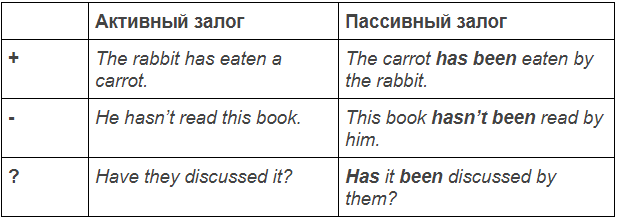
Past Simple
Прошедшее простое. Конечно же, здесь добавляем was для единственного числа и were для множественного.
Кстати, мы написали про Past Simple Passive отдельную статью.

Past Continuous
Вспомогательные глаголы будут такие: was/were, как для прошедшего простого времени, плюс being, как выражение длительного аспекта.
Узнать больше про Past Continuous Passive
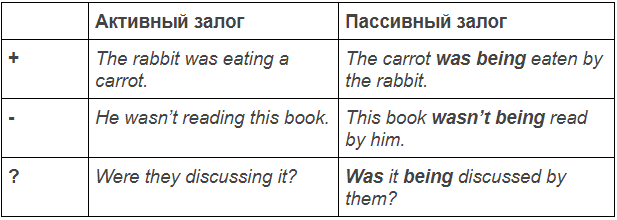
Past Perfect
Конструкция, которая постоянно встречается в пассиве — это had been. Подробно мы обсуждали это здесь:
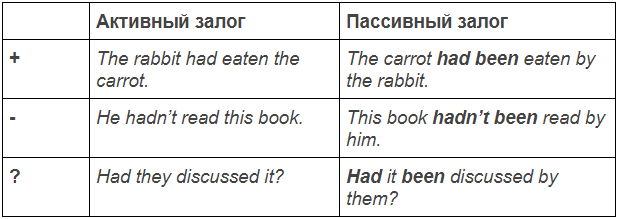
Future Simple
Это будущее простое, соответственно, и формирование пассивной формы простое — к will добавляется be. Ну и Past Participle, конечно же, не забываем.

Future Perfect
В любом перфекте всегда фигурирует глагол have. Вот и в будущем совершенном времени он стал частью конструкции: will have been. Статья, где мы рассказываем, насколько все это просто, находится здесь.
Внимание! Следующие времена:
- Present Perfect Continuous,
- Past Perfect Continuous,
- Future Perfect Continuous,
- Future Continuous,
используются только в активной форме. Иначе получаются уж слишком громоздкие конструкции, типа такой:
The carrot has been being eaten by the rabbit.
Это уже перебор, согласитесь.
Активный залог в английском языке — лучший выбор?
Если вы начинающий писатель (а вдруг?), то только ленивый не посоветовал вам строить предложения исключительно в активном залоге. Мол, так текст получается более живым и доходчивым.
Это правда. Passive Voice should never be used. (Страдательный залог никогда не должен быть использован).
На самом деле, это шутка (если вы поняли, в чем ее суть — вы просто супер-сообразительны). Каждый залог хорош в свое время и в своем месте.
Случаи, когда страдательный залог очень выручает
- Сообщения о совершенных преступлениях или происшествиях, виновники которых неизвестны.
Her diamond ring was stolen yesterday.
Ее кольцо с бриллиантом вчера было украдено.
Здесь использование пассивного залога подчеркивает, что именно было украдено и сам акт кражи.
Даже если речь идет не о преступлениях и чрезвычайных происшествиях, а о чем-то хорошем, иногда совершающий действие не упоминается или упоминается вскользь, как дополнение. Показательны в этом смысле примеры с благотворительностью, так как меценаты часто предпочитают оставаться в тени:
Over four million dollars were donated to educational institutions last year.
Более четырех миллионов долларов было пожертвовано образовательным организациям в прошлом году.
$410 billion was given to charity in 2017.
410 миллиардов долларов было пожертвовано на благотворительность в 2017.
- Научный контекст.
The chemical reaction was not observed at that time.
Химической реакции в тот раз не наблюдалось.
The experiment was being held from May 2008 until August 2010.
Эксперимент проводился с мая 2008 по август 2010.
Кто проводит опыты, наблюдает химические реакции? Конечно, ученые. Это очевидно и не является особо ценной информацией. Что действительно важно, так это сами исследования, реакции и прочие результаты, которые и ставятся на первое место в предложении.
- Когда лицо, совершившее действие несопоставимо по масштабу с самим действием.
Napoleon’s life is spoken about a lot.
Много говорится о жизни Наполеона.
- Когда нужно избежать критики и обвинений.
«Mistakes were made» — были сделаны ошибки. Кто их сделал? Кто возьмет на себя ответственность? Есть ли какое-то решение? Пассивный залог позволяет обойти все эти вопросы стороной. Так что, если вдруг что-то пойдет не так, как вы планировали — имейте в виду, что есть такой элегантный способ замалчивания своей вины.
The conflict had been started.
Конфликт был начат.
The decision wasn’t made in time.
Решение не было принято вовремя.
The money was spent.
Деньги были потрачены.
- В литературе, чтобы создать комический или другой эффект по усмотрению автора.
В романе Джейн Остин «Гордость и предубеждение» просто переизбыток пассивного залога. Но, с другой стороны, как иначе передать отношения внутри этого чопорного английского мирка?
He was looked at with great admiration for about half the evening.
Почти половину вечера на него смотрели с невероятным восхищением.
(Это про мистера Дарси, а восхищение было вызвано, по большей части, слухами о его приличном состоянии).
Elizabeth listened in silence but was not convinced.
Элизабет слушала молча, но не была убеждена.
Miss Bennet was therefore established as a sweet girl.
Мисс Беннет с тех пор была объявлена милейшей девушкой.
The visit was soon returned in due form.
Визит был должным образом возвращен.
Писатели девятнадцатого века вообще частенько избегали напрямую, «в лоб» называть субъекты действия. Вот, например, характерные отрывки из «Войны и Мира» Льва Толстого:
Виконт был подан обществу в самом изящном и выгодном для него свете.
О нем было доложено государю, и, не в пример другим, он был переведен в гвардии Семеновский полк прапорщиком.
Литературные произведения, изобилующие использованием пассивного залога, конечно, не так легко читать, но, наловчившись ухватывать смысл за пассивными конструкциями, можно получить много удовольствия от деликатности и тонкого юмора писателей той эпохи.
Итак, сегодня вы узнали многое про структуру английских предложений, и, конечно, про залоги — как и где они используются.
Даже если вы забудете, как формируются Passive и Active Voice — таблица, где рассмотрены все времена, вам поможет. Кстати, не забудьте добавить эту страницу в закладки!
When we talk about active voice and passive voice in English, we refer to sentence structure (word order). In the active voice sentences, the subject of the action is evident. In passive voice sentences, the object of the action is evident. To understand the English language better and therefore improve your English at the same time, it’s essential to know the two types of voice and their respective constructions.
To begin with, look at the following examples:
ACTIVE VOICE
“Julia bought the new Game of Thrones book.”
PASSIVE VOICE
“The new Game of Thrones book was bought by Julia.” se p
The sentence structure in the active voice is the most common, it’s the first one we learn, the clearest, and the one we use the most on a daily basis.
WHO DOES THE ACTION (the subject) + VERB + OBJECT RECEIVING THE ACTION
“Julia + bought + the new Game of the Thrones book.”
Sentence structure in the passive voice is not so common in everyday language. However, it is very important to know how to construct sentences in the passive voice in order to acquire a good level of English grammar throughout the course of learning the language.
OBJECT OF THE ACTION + “TO BE” (using same tense as the main verb in the active voice sentence) + PAST PARTICIPLE (the main verb of the active voice in the past participle) *+ PREPOSITION ‘BY‘ + WHO DOES THE ACTION (the subject)
*If we wish to say who does the action, we use “by + subject” at the end of the sentence.
“The new Game of the Thrones book + was + bought + by + Julia “
“I still don’t quite understand when passive voice is used”.
We use passive voice when the person doing the action is unknown or not relevant to the type of information we want to pass on. In this case, emphasis and importance is on the action, not the person. Examples:
“The eclipse can be observed tonight.”
“The car was stolen.”
“A new shopping mall was built near our school. “
Now it’s your turn to practise. Change the following ACTIVE VOICE sentences to the PASSIVE VOICE. Don’t forget! Change the verb “to be” in the passive voice using the tense of the main verb in the active voice. If you have any questions, our native teachers can help you or write your questions in the comments and we will answer them 🙂 🙂
EF English Live
Founded in 1996, EF English Live has been at the cutting edge of language learning for nearly two decades, having been the first to pioneer a 24-hour teacher-led online English course. Backed by a world-class team of academic and technical experts, plus two thousand certified online English teachers, our mission is to use technology to create a fundamentally better way to learn English.
Though fun, writing can also get pretty darn confusing, especially when you’re trying to figure out whether to use the active or passive voice. What is the difference between active and passive voice? When and how should you use them?
In this complete active voice vs passive voice guide, we’ll go over how each voice works in English grammar, when to use the two voices, and how to change a sentence from passive to active (and vice versa). We’ll also give you an active vs passive voice quiz to test your skills. Let’s get started!
What Is Active Voice?
The active voice is when the subject of a sentence performs an action on an object. In other words, the subject does the action, and the object receives the action.
The active voice is easy to identify in writing because it follows a simple form, which is the basis of English grammar:
Subject (doer) → Verb → Object (recipient)
Here’s an example of a sentence using the active voice:
The dog ate my homework.
In this example, «the dog» is the subject, «ate» is the verb, and «my homework» is the object. Here’s a diagram to better show this connection:
|
Subject |
Verb |
Object |
|
The dog |
ate |
my homework |
Here, «the dog» is doing (or, in this case, has already done) the action: it is the one that «ate.» Meanwhile, «homework» is the object that is receiving this action of eating.
Here’s another example of the active voice at play:
She is writing an essay.
In this example, «she» is the subject, «is writing» is the verb (in the present progressive tense), and «an essay» is the object.
Once again, the subject («she») is the one performing the action: «she» is «writing.» And what is she writing? An «essay,» i.e., the noun that’s receiving the action.
Finally, here’s an example of the active voice being used without an object:
He sings.
In this sentence, we have a subject («he») and a verb («sings») but no object. Regardless, because the subject is performing the act of singing, we can identify this as the active voice.

What Is Passive Voice?
The passive voice is basically the opposite of the active voice: it’s when the subject is acted upon by the object. In other words, the subject receives the action, and the object does the action.
The passive voice is a little trickier to identify, as it uses more words than the active voice. The basic structure is as follows:
Subject (recipient) → Verb (past participle of «to be» form) → Object (doer)
Note that the object here is always preceded by the word «by.»
Additionally, the verb takes its «to be» form (meaning it’s preceded by «is/are» for the present tense and «was/were» for the past tense) and is put in the past participle (e.g., «eaten» for the verb «eat» or «given» for the verb «give»).
Here’s an example of a sentence using the passive voice:
The ice cream was bought by the little girl.
In this example, «the ice cream» is the subject, «bought» is the verb, and «the little girl» is the object. Here’s a diagram to help you understand this grammar pattern better:
|
Subject |
Verb |
Object |
|
The ice cream |
was bought |
by the little girl |
As you can see, «the ice cream» (as the subject) is the one receiving the action, while «the little girl» (as the object) is the one performing the action.
Here’s another passive voice example:
Our tests were graded by the teacher.
Here, the subject is «our tests,» the verb is «were graded,» and the object is «the teacher.» Again, the subject («our tests») is receiving the action from the object («the teacher»), which is, in turn, performing it (i.e., the one who is grading).
Sometimes you’ll see the passive voice being used without an object (i.e., without identifying the doer of the action—only the recipient). Here’s an example:
The tea was poured.
In this sentence, «the tea» is the subject and «was poured» is the verb; however, there’s no object performing the action of pouring. Simply put, we don’t know who poured the tea! Nevertheless, we can identify this sentence as passive based on its setup: a subject followed by a verb in its past participle «to be» form.
If we wanted to insert an object here, we’d simply add the word «by» followed by a noun:
The tea was poured by my grandmother.
Now, we have an object, or doer, of this act of pouring tea: «my grandmother.»
Active vs Passive Voice: When Do You Use Them?
The active and passive voice express the same ideas, just in different ways. In terms of when we actually use them, though, what is the difference between active and passive voice?
In general, you should always aim to use the active voice whenever you write. This is because the active voice is clearer and more direct, while the passive voice is wordier and more confusing.
That being said, this doesn’t mean that the passive voice is inherently wrong. There are many cases in which you might opt for the passive voice over the active voice.
Here are some scenarios in which you might want (or need) to use the passive voice:
- When you want to emphasize the recipient of the action
- When you want to emphasize the action itself
- When you don’t know who or what is performing the action
- When the doer of the action is irrelevant or unimportant
For example, say you’re writing an essay about the Declaration of Independence and you come up with the following sentence:
Most people believe that the Declaration of Independence was signed on July 4, but this is not actually the case.
Let’s parse this out a bit.
While part of the sentence is clearly in the active voice (the «most people believe» section), the crux of it («the Declaration of Independence was signed on July 4») is in the passive voice. Doing this lets you keep the emphasis on the document, i.e., the topic of your essay.
In addition, there were many people who signed the Declaration of Independence, but listing them all here would only make the sentence longer and more convoluted; this is why the passive voice is a better fit.
Changing From Passive to Active Voice (and Vice Versa)
There are many times you might want to change a sentence from passive to active, or even from active to passive. To do this, you’ll need to understand exactly how the two types of voices work.
First, recall that the primary difference between active and passive voice lies in the roles of the subject and object: whereas in active voice the subject is the doer and the object is the recipient of the action, in passive voice the subject is the recipient of the action and the object is the doer.
Here’s an example of a sentence in the active voice vs passive voice:
Active: She created a travel blog.
Passive: A travel blog was created by her.
Below is another way of looking at the difference between active and passive voice:
|
Subject |
Verb |
Object |
|
|
Active Voice |
She |
created |
a travel blog |
|
Passive Voice |
A travel blog |
was created |
by her |
As you can see here, in the active voice, «she» is the subject and doer, whereas «a travel blog» is the object and recipient of the verb «created.»
But in the passive voice, these designations swap: as the original subject, «she» becomes the object (but is still the doer of the action), whereas «a travel blog,» which was originally the object, becomes the subject (but is still the recipient of the action).
In addition, the verb, which began in the simple past, has been converted into its past participle «to be» form.
To sum up, to convert from active to passive voice, here’s what you must do:
- Switch the positions of the subject and object so the original object is now the subject and the original subject is now the object
- Add the word «by» before the new object
- Convert the verb into its «to be» past participle form based on the original tense used
Most likely, though, you’ll need to convert from passive to active. The process for this is essentially the same—just backwards:
- Switch the positions of the subject and object so the original subject is now the object and the original object is now the subject
- Delete the word «by» used before the original object (now subject)
- Convert the «to be» past participle form of the verb into the appropriate tense as indicated by the verb and overall sentence
The verb is arguably the trickiest part of converting from passive to active. You want to make sure you’re keeping the same tense as indicated by the original verb and sentence.
As an example, here’s how you’d change various tenses of the word «do» from passive to active:
- is done → do/does
- is/are being done → is/are doing
- was/were done → did
- was/were being done → was/were doing
- will be done → will do
Finally, know that you cannot convert from active to passive or passive to active if you do not have an object. You can see why this doesn’t work in these active vs passive voice examples:
Active (Without Object): I drank.
Passive: ??? was drunk by me.
Without an object, we have no idea what «I» actually «drank.»
Passive (Without Object): The project will be completed by tomorrow.
Active: ??? will complete the project by tomorrow.
Without an object, we cannot explain who «will complete the project.»
It’s time to test out what you learned in an active vs passive voice quiz.
Before you start, make sure you know what the three types of questions expect you to do:
- Questions 1-3: Identify whether the sentence is active or passive
- Questions 4-5: Fill in the blanks to create a grammatically correct sentence
- Questions 6-8: Convert the sentence from active to passive, or vice versa
Answers and explanations will be provided at the end of the quiz. Good luck!
#1: Active or Passive?
This novel was not written by Charlotte Brontë but rather her sister Emily.
#2: Active or Passive?
The mail arrived on time yesterday.
#3: Active or Passive?
A study on the gender wage gap was conducted in 2018.
#4: Fill in the Blank
This gift was given to me _____ my sister.
#5: Fill in the Blank
The toy will soon be _____ by him. (past participle of «fix»)
#6: Convert to Passive
Jessica is teaching me how to speak Italian.
#7: Convert to Active
He was advised by his dentist to floss more.
#8: Convert to Active
The valuable painting is finally going to be sold this year.
Active vs Passive Voice Quiz: Answers + Explanations
#1: Active or Passive?
This novel was not written by Charlotte Brontë but rather her sister Emily.
In this sample sentence, the subject is «the novel,» the action is «was not written,» and the object is «Charlotte Brontë»—we can leave out that last part since it’s not really important to understanding the voice here.
Because the object («Charlotte Brontë») is the doer of the action—that is, she’s the one who did not write «the novel»—you should be able to tell right away that this sentence is in the passive voice. (You might also be able to tell it’s passive due to the use of the word «by» before the object.)
#2: Active or Passive?
The mail arrived on time yesterday.
Here, «the mail» is the subject and «arrived» is the verb—there is no object. Because «the mail» is the one doing the action of «arriving,» this sentence uses the active voice.
#3: Active or Passive?
A study on the gender wage gap was conducted in 2018.
In this example, «a study» is the subject and «was conducted» is the verb; there’s no object. Since «a study» is receiving the action instead of performing it, this sentence is in the passive voice.
(Just in case you’re wondering, the reason we don’t see «by» is that the object, or doer, of the action is either unknown or irrelevant.)
#4: Fill in the Blank
This gift was given to me _____ my sister.
Right away you should recognize this as the passive voice. «This gift» is the subject, «was given» is the verb, and «my sister» is the object who is performing the action of giving.
As you know, the word «by» must come before the object in a passive sentence, so this is the missing word. The sentence should therefore read, «This gift was given to me by my sister.»

#5: Fill in the Blank
The toy will soon be _____ by him. (past participle of «fix»)
Again, you should recognize this example as a passive sentence since it calls for the past participle of the verb and has the word «by» before the object. The past participle of the verb «fix» is the same as its simple past: «fixed»; therefore, the sentence should read, «The toy will soon be fixed by him.»
#6: Convert to Passive
Jessica is teaching me how to speak Italian.
To convert this sentence from active to passive, you must switch the positions of the subject and object and then convert the verb (in present progressive) to its past participle «to be» form. Don’t forget that «me» must transform into its subject form («I») when going from an object to a subject. («Jessica» is a name and proper noun and therefore does not change form.)
Finally, place the word «by» before the new object («Jessica»). This should give you the following passive sentence: «I am being taught how to speak Italian by Jessica.»
#7: Convert to Active
He was advised by his dentist to floss more.
To convert this example from passive to active, you’ll need to switch the subject and object, change the verb form from «to be» past participle to simple past, and eliminate the «by.» Note that «he» will turn into «him» when converted from a subject into an object.
Doing all this correctly should give you this: «His dentist advised him to floss more.»
#8: Convert to Active
The valuable painting is finally going to be sold this year.
If you didn’t know it already, this question is actually a trick! But how? Because there is no object in this passive sentence, there’s no way to convert it into the active voice. In other words, we have no idea who is going to sell the painting.
If we tried to convert it, we’d get this nonsensical statement: «??? is finally going to sell the valuable painting this year.» As such, we cannot create a sentence in the active voice without a subject.
What’s Next?
Now that you understand active voice vs passive voice examples, want to brush up on your English grammar? Then check out our detailed guides on semicolons, verbs, prepositions, proper nouns, and parts of speech.
To ace the SAT/ACT, you’ll need to have an excellent grasp of the English language. Learn the most important SAT grammar rules and ACT grammar rules so you can earn an amazing score.
Need help with using and identifying literary devices? Our expert guide explains more than 30 key literary devices and how they work to help you become a pro at reading and writing.
Need more help with this topic? Check out Tutorbase!
Our vetted tutor database includes a range of experienced educators who can help you polish an essay for English or explain how derivatives work for Calculus. You can use dozens of filters and search criteria to find the perfect person for your needs.
Have friends who also need help with test prep? Share this article!
About the Author
Hannah received her MA in Japanese Studies from the University of Michigan and holds a bachelor’s degree from the University of Southern California. From 2013 to 2015, she taught English in Japan via the JET Program. She is passionate about education, writing, and travel.


